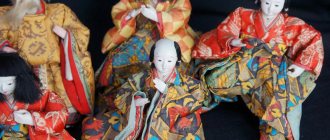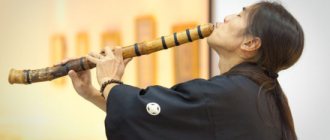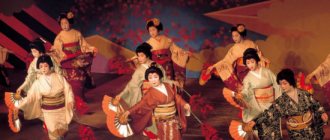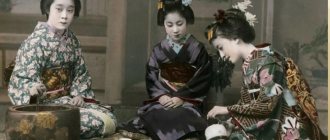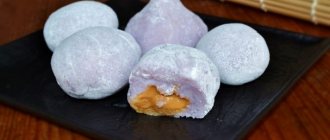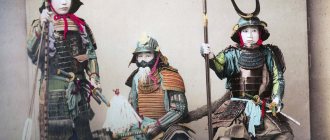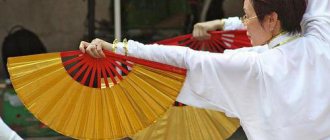Traditional Japanese kokeshi dolls are made of wood and covered with painting. You can find them in various cities in Japan. They are sold everywhere: in souvenir shops, airports, department stores. These cute wooden souvenirs are produced only in the six northern prefectures of the island of Honshu: Aomori, Akita, Iwate, Miyagi, Fukushima, Yamagata.
The dolls appeared at the end of the Edo clan period, marked in the history of the country as an era of prosperity of literature, arts and crafts. Kokeshi is considered a Japanese Renaissance doll.
The emergence of tradition
The kokeshi doll began to be sold as souvenirs in hot spring areas in the mid-19th century. It is said that some artisans who made wooden utensils began to make wooden dolls from the leftover material. In the old days, Japanese farmers loved to enjoy the waters of hot springs in between field work. Thus, hot spring areas were places where many people gathered. Visitors bought dolls for their children and as gifts for friends. The shades of red used in painting were credited with the ability to drive away illness. Dolls have acquired a reputation as a kind of amulet or talisman. They quickly gained popularity. The technique of creating kokeshi developed, and over time, dolls became not just a souvenir, but a folk art.
Japanese Kokeshi dolls - a prototype of the Russian nesting doll (photo report)
Ralina Kurbanova
Japanese Kokeshi dolls - a prototype of the Russian nesting doll (photo report)
While working on the Russian Matryoshka , I learned a lot of new and interesting things. It was then that I met such wonderful dolls as Kokeshi ( Kokeshi )
.
According to one version, it was Kokeshi who became the prototype of the Russian nesting doll .
Similarities between Matryoshka and Kokeshi :
- made of wood;
— the coloring uses floral and plant motifs in red, black, yellow and crimson;
— height about 24 cm;
— detachable dolls;
Kokeshi dolls come in traditional and original varieties. The design of original Kokeshi is more varied ; sizes, proportions and colors can be any.
On the Internet I found many ways to make Japanese dolls , but the most acceptable and accessible method was the method of making Kokeshi . The children took an active part and our dolls turned out bright and beautiful! They joined the ranks in our mini-museum “ Matryoshka ” in the section “The history of the appearance of Matryoshka ”.
A master class on making Japanese dolls is presented in the presentation.
Thank you for your attention!
Attached files:
GCD in the preparatory group “Dolls in Rus'.
Making a folk doll" Summary of the GCD lesson on the topic: "Dolls in Rus'. Making a folk doll" Participants: children of senior preschool age. Amount of children:. Summary of a lesson on making a rag doll for children and parents in the senior group “What a beauty these dolls are!” “What a beauty these dolls are!” Goal: to introduce children to Russian folk culture through the image of a traditional rag doll. Objectives: Educational:. Master class on making a Russian traditional rag doll “Bell” Master class (description) on making a Russian traditional rag doll Bell doll Teacher: Volkova L. A. MKDOU for children. Master class on making Russian traditional dolls Objectives: 1. Expand knowledge about Russian folk dolls, methods of making dolls. 2. Introduce methods and techniques for working with children. Pedagogical project for children of senior preschool age “Folk dolls. Dolls-amulets" Pedagogical project For children of senior preschool age "Folk dolls. Dolls are amulets." MADOU No. 57 “Thumbelina” Educator:.
Photo report. Introduction to the origins of Russian folk culture “Acquaintance with the Russian stove” (second junior group) And here is the stove, in all its glory. Table with household utensils. The children came to the hut, and the Hostess met them and invited them to visit. Come in, guests.
Continuing education program “History of Russian folk dolls” (integration of artistic creativity and museum pedagogy) Implementation period – 1 year. Children's age is 6-7 years. Additional teacher
Creation of a Russian folk doll in the middle group. Master class Russian doll is the most mysterious and mysterious symbol of Russia. In ancient times, she was not just a toy, she was a talisman.
Source
First purpose
Initially, wooden dolls were made as the first toys for children. The kokeshi shape is most convenient for small hands to grasp. The toys were loved not only by children, but also by visitors to the hot springs, who bought them as souvenirs. There is an opinion that the workers of the springs used kokeshi as equipment for carrying out health procedures. There are other versions of the origin of the craft, some of which, although not confirmed, still excite the minds of researchers. One of these assumptions includes the version about the symbolic representation in dolls of children who have become victims of abortion. This version was stumbled upon by linguists who found out that in Japanese, different phonetic parts of words can have different meanings and, accordingly, can be represented by different hieroglyphs, among which there is the sign “ko”, expressing “child” and “keshi”, meaning “erasure” or "elimination". Thus, followers of this interpretation believe that cute and gentle little dolls made of wood, with a spherical head and a cylindrical body, may represent children killed at birth.
Infanticide was not an uncommon practice in rural areas of Japan during the feudal era. American historian Thomas K. Smith suggests that in the eighteenth and early nineteenth centuries, this practice was a desperate act in conditions of poverty, as a form of family planning. In cities and rural areas of the country, a decision was made at the government level to refuse the sale of contraceptives. Despite the official ban on abortion, for many families, infanticide was a necessity. The birth of twins was also considered a big bad luck. The absence of clearly defined limbs in dolls, from the point of view of adherents of this version, only emphasizes the method of getting rid of babies tightly wrapped in rags before death. And Japanese ghosts seem to be creatures without legs. Dolls were carved to replace the loss of a child.
According to another version, kokeshi were cut out for all children at birth. It was believed that the young soul would remain in the doll until it grew up. As they grow older, the child’s soul will be kept in the doll, while the adult’s will live on.
Kokeshi dolls
Honoring the culture of the East and love for beauty inspired designers to create an amazing line of delightful gifts and stylish interior items.
Traditional Japanese Kokeshi dolls are a wonderful example of the modest and elegant beauty of the East. The art of making Kokeshi dolls dates back to the 19th century. In those distant times, peasants gave each other such dolls as a sign of Love or Friendship. Kimmidoll kokeshi doll “Kanako (Brightness)”. It is the philosophy of giving good luck and happiness to loved ones that underlies the Kimmidoll brand. These amazing dolls have already captured the hearts of over 50 countries including Australia, UK, France, Italy, Spain, Portugal, Netherlands, Ireland, South Africa, New Zealand, Chile, Argentina, Singapore, Hong Kong, Japan, Korea and the United Arab States. Emirates.
The idea of Kimmidoll is the creation of a family of modern Kokeshi dolls,
each of which personifies one of the “true values of life.”
We recently bought books from the Kokeshi series - Kimono and Yumi. And since then (the books are some of my favorites), I really wanted to find the kokeshi dolls themselves on sale. And they were finally found! And a lot at once, on sale here:
- Dolls with soft hairstyles “Ice cream squishy style”, 12 cm165
- Dolls with soft hairstyles “Ice cream squishy style”, 3 pieces 336
- Collectible doll “Schildkröt Gudrun Legler. Gray", 53 cm, art. 5025089022500
- Decorative doll “Lefard. Magic Fairy", 62 cm, art. 485-5005661
- Decorative doll “Lefard. Magic fairy", 62 cm5661
- Decorative doll “Lefard. Magic Fairy", 62 cm, art. 485-5015661
- Collectible doll “Schildkröt Rolanda Heimer. Anika", 53 cm, art. 2825364622500
- Collectible doll “Schildkröt Natali Blick. Melissa", 50 cm, art. 4805074323500
- Collectible doll “Schildkröt Rolanda Heimer. Nina", 53 cm, art. 2925374422500
- Decorative doll “Lefard. Angel", 46 cm, art. 485-5062984
On sale there are both simple dolls and kokeshi dolls on keychains. There are different sizes - mini, maxi... There are also very large ones, 40 cm. Material: artificial stone (polyresin), high-quality plastic.
See the review article - detailed photos of kokeshi pupae.
Mini size
— kokeshi doll height — 6 cm, diameter — 3 cm.
Maxi size
— kokeshi doll height 10-10.5 cm, diameter — 6 cm. Doll height (without ring) on keychains: 5 cm.
A huge collection and many characters will help you choose the most suitable gift for each person. These cute dolls will always remind you of the most important moments in your life. Constant updating of the product line, the emergence of new characters and symbols will allow you to always find something new and unusual for yourself.
All Kimmidoll products are united by the desire to ensure that kindness, happiness, joy and respect always triumph in your life.
Kokeshi (Japanese nesting doll) is a traditional Japanese doll. Given as a sign of friendship, sympathy, love or on the occasion of any pleasant event! It is believed that this is not only a pleasant souvenir, but also a talisman that brings good luck in business, prosperity in the home and harmony in the soul!
The mascot doll is packaged in a gift box and has a unique passport description (in English).
In addition to Kokeshi dolls, the catalog also includes handbags, phone cases, bracelets, mirrors, and cosmetic bags in the Kokeshi style, with their images.
Traditional and designer kokeshi dolls
There are many types of dolls in Japan. At first glance they may seem the same, but upon closer inspection it is easy to notice that each of them has its own author’s handwriting and regional characteristics. In addition, they can be classified as traditional handicraft samples, as well as designer samples. Traditional ones have a simple design, round faces and a cylindrical body. If you come across a sample with a hairstyle carved from wood, then this means that you are looking at a sample of a designer doll. The original products are produced in the Tohoku region, which is located in the north of the country. A doll maker is called "kozin" in Japan, where the first word means doing the work with tools and the second means man. Shapes and patterns vary depending on the area in which the doll was made. The secrets of the craft are passed on from the master to his students.
Types of kokeshi
Dolls are divided into traditional and modern.
Classic kokeshi
(dentou-kokeshi, Japanese 伝統こけし) have a simpler shape. They are made in accordance with the original style and canonical features. Among them, there are about ten to eleven varieties (often their names are associated with the name of a particular onsen or area). Some of the most famous are togatta and naruko.
By the way, in Naruko, where, according to some opinions, kokeshi appeared, the Japanese national museum of these wonderful dolls is located. Traditional types of kokeshi differ from each other in the shape of the body, head, style of drawing patterns and facial features. The picture on the left shows these nuances clearly. Some have almond-shaped eyes, others are more round; Some have a contemplative, calm look, while others have a more energetic look.
Modern or designer dolls
(shingata-kokeshi, Japanese 新型こけし) have a greater variety of shapes, colors, and designs. Such creative kokeshi began to actively appear in the mid-20th century. And in general, they are not tied to any specific region of the Land of the Rising Sun.
Traditional kokeshi doll schools
Today, eleven schools of traditional kokeshi dolls survive. Each school has its own distinctive shapes and patterns that reflect the culture of the area they represent. Tsuchyu School in Fukushima Prefecture, Yaziro, Sakunami, Naruku and Togata Schools in Miyagi Prefecture, Yamagata, Hishiori and Zao in Yamagata, Kiziyama in Akita Prefecture, Nanbu in Iwate and Tsugaru in Aomori Prefecture. The tradition of the school is passed on to family members, less often to apprentices. The master takes a long time to master and improve his skills. Men and women participate equally in production. Most of today's artisans belong to the age group of 50 to 65 years.
Golden Age of Kokeshi
At the beginning of the 20th century, doll making received a powerful impetus for development. This is a credit to Japan's rapid industrialization. Regions famous for their hot springs welcomed more and more vacationers, each of whom took home a souvenir. However, after the "golden age" of kokeshi, production declined due to the popularization of materials such as tin and celluloid. Interest in the original fishery has decreased.
In 1928, the first book devoted to the study of this craft was published. It was written by Japanese researcher Amae Tomiya.
Seven human bodies
There is another version of the origin of the Japanese nesting doll. The toy, according to her, was connected with Eastern philosophy by a Russian monk who fled to Japan. The prototype of this nesting doll was the image of Fukuruma (or Fukurokuju).
In Japanese tradition, there are seven gods of happiness - the so-called Shichifukujin, each of which controls only one of the seven human bodies. Among them there is one who is responsible for wisdom, high intellectual abilities and wealth - Fukuruma. The Japanese nesting doll with his image has its own unique features. This is, first of all, a high, elongated forehead, on which deep wrinkles are visible, and the staff that Fukuruma holds in his hands.
But how did the nesting doll itself appear? No one can say for sure. It is believed that once upon a time an unknown Japanese master created seven shichifukudzin dolls and placed one inside the other. The largest and most important among them was Fukuruma. His entire “divine” family was hiding in him.
Manufacturing technology
Making a doll begins with finding suitable wood. The master prepares the wood and places it to dry. After drying, the wood is cut into pieces of a given length, the excess top layer is cut off so that the workpiece is suitable for a lathe. This work requires physical strength and mental concentration, a strong hand and a keen eye.
Craftsmen believe that the older the tree, the more “mature the wood” is, and therefore the colors will adhere more thoroughly. Having found the workpiece, the master secures it on the lathe. In the old days, a hand loom was used. First the head is shaped and then polished. Using a brush, a hair pattern is applied. Coloring occurs during rotation. A skilled craftsman only needs to touch the head with a brush and the desired ornament is already ready. Next comes the manufacture of the body. Having attached another blank, a body appears from under the large incisor. Finer cutters are used to cut out parts. After which, a hole is drilled in the upper part into which the head will be inserted. Having thoroughly polished the part, the master begins to transform it with the help of paints. The most difficult task is the final assembly of the pupa. Craftsmen connect parts using the capabilities of dry friction friction. The final touch is to apply the design to the face. To make a mistake at this stage means to ruin all previous efforts.
Paints and brushes
The surface decoration is done with a traditional Japanese brush using black ink, which is hand-prepared by artisans using pigment and a water base. The predominant colors used in painting are: red, green, purple and yellow. Blue is not used as it is considered a cool color. Unlike blue, red is considered a favorable, protective warm color. It is most often used in northeastern Japan, which has a cold winter climate with frequent heavy snowfalls. Since water-based paint is used, it is necessary to keep the products away from moisture and sun. Otherwise, the colors actually disappear: green fades first, red and black disappear behind it.
Wood
Different craftsmen prefer to use different types of wood in their work. One of the most popular types of wood is sakura; maple is no less in demand; persimmon, dogwood, and pear are also used. The wood used in manufacturing affects the nature of the product. This is how craftsmen achieve a variety of basic shades. The structure of the wood is revealed in the final work. Dolls made from sakura are darker, and Japanese maple makes almost weightless toys. Dogwood is very popular because of its softness and pliability. The first traditional dolls were made from this wood, since the manual lathe used at the beginning of the craft was easier to do the job.
Showroom
Some experts believe that kokeshi appeared in Japan a thousand years ago, while others claim that these wooden dolls were born during the Edo era (1630-1867). Centuries-old traditions of kokeshi making are preserved in Tohoku, the northeastern agricultural region of the country famous for its hot springs.
There are several versions of the origin of kokeshi. The first version says that kokeshi came from ritual figurines depicting patron spirits. According to the second version, wooden funeral figurines became the prototype. They were installed in homes in memory of children who died in infancy. There is a more cheerful story. They say that during the Edo period, the wife of the shogun came to Tohoku, suffering from infertility. She heard about the healing power of hot springs, and hoped to use it to cure her illness. Soon after this trip, her daughter was born. In honor of this joyful event, local craftsmen made the first kokeshi doll.
According to the official point of view, the kokeshi we know originated in Tohoku, in northeastern Japan. They were created by woodworking masters - carpenters (kidziya), who made their living by making household utensils and other household items. Dolls began to be offered to people who came to relax at hot springs (onsen). Onsen owners used kokeshi as omiyaga souvenirs to reward regular customers.
Gradually kokeshi became popular. People believed that they would help reap a good harvest and bring prosperity and good luck to their homes. If children played with such dolls, it was believed that this would definitely make a positive impression on the gods. It has become customary to pass kokeshi down in families from generation to generation.
Wooden dolls were called differently in different regions of the country. In Fukushima - “kideko” (ki - wooden, deko - type of doll). In Miyagi - “kiboko” (ki-wooden, boko (hoko) - crawling doll). Kokeshi is the name of a doll in Sendai (ko is small, possibly wooden, keshi from keshi-ningyo, a small terracotta doll that was made in the area around Sendai). Kokeshi, as a representative name, was adopted in 1940 by the Tokyo Kokeshi Collectors Club, the general meaning being a wooden small doll.
Crafting kokeshi requires skill. Craftsmanship must be perfected and style must be honed within established traditions. All this is passed on from the master to his students, who are often their own children. Sometimes wives learn creative secrets from their husbands, also becoming masters over time. Lineages of dynasties are carefully documented, and changes in the development and style of kokeshi are necessarily recorded.
The oldest kokeshi schools are Togatta and Naruko. Their influence can be seen in dolls of other schools. Today, eleven recognized centers represent the "aristocracy" of kokeshi. In total, there are 11 styles (schools) of traditional kokeshi, in addition to those already mentioned, these are Tsuchiyu, Yajiro, Sakunami, Yamagata, Kijiyama, Nanbu, Tsugaru, Zao, Hijiori. The names are associated with the hot springs near which the Kijiya lived.
Various types of wood are used to make kokeshi. The most popular are cherry, maple, persimmon, and white dogwood. The type of wood, its texture and color affect the character of the doll being made. Harvesting usually takes place at the end of September - the first half of October and 15-20 year old trees are used. The harvested wood is sanded and allowed to dry thoroughly for a certain period of time. Traditionally this takes from one to five years. After this, the wood is sawed into logs of the required length, the excess is cut off, and figurines of future kokeshi are made on a lathe. The first kokeshi were made in three sizes - 12, 18 and 24 cm. Starting from the Taisho period (1912-1926) - early Showa (1926-1989), the variation in parameters became much more significant. The design of a traditional doll is simple: it has a long cylindrical body without arms or legs, crowned with a large spherical head. In some styles of kokeshi the head and body are carved separately, while in others the entire figure is carved. Traditional kokeshi are characterized by maximum laconicism - the absence of decorative carvings and an ascetic color scheme, usually limited to black, red and yellow, sometimes green is also found. In a number of centers of artistic crafts, over time, local features of kokeshi painting were formed. For example, in the town of Naruko, dolls are painted with lush scarlet chrysanthemums, and in the city of Togatta, the cylindrical body of the kokeshi is usually covered with small repeating floral patterns, and the nose is drawn in the form of an inverted triangle. Kokeshi Yajiro from Miyagi Prefecture is characterized by widening at the bottom of the body (and sometimes a narrowed waist) and painting with rings. If a kokeshi is created by one master, then, as a rule, one day is devoted to making the figurine, and the second day to painting it. When finishing work on the kokeshi, the master puts his signature on the doll.
Kokeshi made using traditional technologies is called “dento-kokeshi”. After the Second World War, the so-called “singata-kokeshi” also appeared (singata is a new type). Masters of this trend do not limit themselves to traditional styles. Material, shape, painting depend only on the imagination of the creator.
Thanks to the advent of shingata-kokeshi, after World War II, the production of these souvenirs was actually put on stream. Dolls with complex and unusual body shapes, non-standard painting, and more characteristic faces have become popular. Some masters took the path of simplifying the form and complicating the painting, turning a doll from a single piece of wood and giving it the shape of a ball, egg or stick. Others give kokeshi more realistic features by putting wooden wigs on their dolls, decorating their colorful “kimonos” with carvings or burning, and attaching hats, false sleeves, bows or earrings (of course, also carved from wood) to the figures. Sometimes kokeshi are functional - craftsmen give the appearance of popular wooden dolls to such prosaic objects as salt and pepper shakers, and toothpick jars. Such dolls are made not only in Tohoku, but also in other regions of Japan. Singata authors often live on the outskirts of large cities rather than in rural areas. Kokeshi in this case is a means of expressing a certain theme. Their creators are primarily designers and do not necessarily make the dolls themselves. If the beauty of dento-kokeshi is in the embodied centuries-old tradition, the skill of creating established forms and patterns, honed over centuries, then the value of singata-kokeshi is in the idea that they reflect. You can find clay, plastic and even knitted dolls.
A special place among singata is occupied by the so-called creative or “sosaku-kokeshi” (sosaku is an original creative work). These are small works of art that reflect a specific theme and are often filled with philosophical meaning. If traditional kokeshi reflect local flavor and repeat the features of a style that has existed for centuries, then sosaku are a one-of-a-kind work of art, an original author’s design.
The shape of the kokeshi, its general appearance, and coloring change, but the truly folk, national essence of the toy remains unchanged.
The exhibition will last until March 13.
Traditional painting
Each of the eleven regions is characterized by a unique painting. So for the Togatta region, first two lines of 6 millimeters each are drawn on a lathe from the bottom of the body, and two lines in the shoulder area, after which the product is finally polished. After removing it from the machine, the master applies floral patterns. The first to appear are the outlines of red chrysanthemums on the body. The painting is done from the bottom left half. Having completed, the master turns the doll head down and applies a drawing to the right side. Having changed the color, the pattern is complemented with leaves in the same order. On the back of the toy, the artist will draw an iris, peony or cherry blossom. The red flowers and green leaves will be painted in the same sequence as the flowers on the front of the doll.
In Yaziro, after polishing, the doll is left on the lathe and the lines are drawn with a brush while rotating. The head is then attached to the body and the top of the head is painted purple, green, red and yellow on a lathe. The combination and order of colors depends on the artisan. After removing the product from the machine, first the right eyebrow is applied, and then the left, then the right upper eyelid from right to left, and then the left. After this, the artist draws the nose, upper lip, and then the lower lip in two steps. Some artisans complement the face by drawing in the cheeks. The outlines of the kimono are drawn in red ink, starting from the collar and ending with the smell.
Sakunami dolls are first painted on a lathe with thick and thin red and green lines. Some dolls only have colored lines, others only have embossed decorations. Typically, more than half the body is covered with turning lines, and floral designs are drawn only on the central part. Flowers are drawn first, then purple and green leaves.
In the Hiziori school, lathe lines are painted on the sanded body with broad red or green lines combined with two-color fine lines. Some artisans paint the kokeshi's body yellow. The toy is then covered with chrysanthemums made with a loose and soft touch.
The Naruku school is characterized by drawing a line on a motionless body. The first thick red lines are applied to the bottom of the kimono, and then thin lines complete the finishing. Then the stripes are applied to the shoulders. Next, the artist uses green paint in a similar way. The application of floral patterns is carried out on a stationary workpiece.
Like body painting, there are also strokes accepted in each school for the final drawing of hair. Masters make about thirty dolls a week. These figures could reach a dozen per day during times of high demand. Vintage kokeshi toys are considered antiques. They can cost thousands of dollars.
